Editor's Choice Award
Our Editor's Choice award goes to products that dramatically exceed expectations for performance, value, or cutting-edge design.
- RGB Laser light source with Rec.2020 gamut coverage
- Authorized Netflix app
- Dolby Vision and 3D Support
- Fairly accurate out of the box
- Low latency for gaming
- Great Contrast
- HDMI 2.1 and 4K/120Hz signal support
- Some image controls do not fully work
- May lack sufficient brightness for images above 120 inches
The Hisense PX3-PRO expands on the growing line of Designed for Xbox projectors with the world’s first RGB laser UST with this designation, showing excellent performance for gaming and movies alike. Its good out-of-box color accuracy, gamut coverage and support for DolbyVision, HDR10+ are sure to impress.
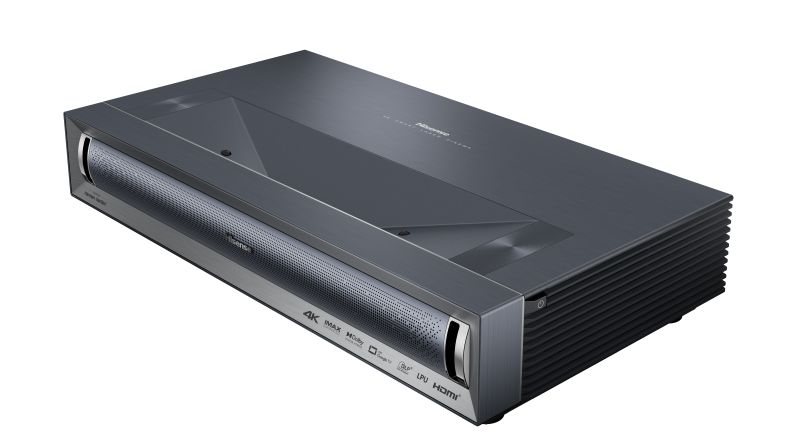
The Hisense PX3-PRO is a new entry in Hisense's line of UST projectors, and it is positioned as their best model yet. It features a proprietary TriChroma RGB laser light engine that uses Hisense's LPU technology, allowing for a wide color gamut, high color accuracy, and a bright display with 3,000 ANSI lumens. With its $3,499 street price, the PX3-PRO offers competitive pricing among well-equipped RGB USTs, alongside some of the best performance we've seen in the UST units we've reviewed.
Released in August, it is also the first "Designed for Xbox" projector we've seen among laser USTs, meaning that it is built in accordance with Xbox's standards and is fully compatible with Xbox consoles. This certification is earned after testing by Team Xbox and meeting their branding and technical specifications, and it provides assurance to buyers that the product was developed in collaboration with Xbox and will provide the best possible experience when used with Xbox consoles.
Features
Like many DLP projectors today touting 4K resolution, the PX3-PRO relies on a native 0.47-inch DLP micromirror chip with a native 1080p array, to which four-phase pixel shifting is applied to achieve a full 4K (3840x2160) resolution on screen. As we've previously reported with other projectors, the resulting image is sharp and detailed, and most viewers would struggle to distinguish it from a native 4K projector.
The PX3-PRO utilizes Hisense's LPU TriChroma RGB triple laser light engine delivering up to 3,000 rated ANSI lumens and 25,000 hours of light to half-life. However, in our testing, the PX3-PRO measured 2,669 ANSI lumens in its brightest picture modes, which falls short but is within the 20% tolerance allowed by the ISO21118 specification. Fortunately, the PX3-PRO did not exhibit any disturbing laser speckle, and the rainbow effect was minimal, appearing only on small highlights or white text when quickly glancing at the screen.
The PX3-PRO offers exceptional color gamut coverage with impressive accuracy. Hisense lists the gamut coverage as 110% of BT.2020, but our measurements showed 94.34% xy and 94.78% uv, which is still excellent. DCI-P3 coverage measured 99.82% xy and 99.78% uv. Unsurprisingly, the PX3-PRO also fully covers the more restricted Rec.709 color space used for standard dynamic range HD content. Most impressively, the PX3-PRO accurately tracked BT.2020, P3, and Rec.709 within the larger BT.2020 color space. While this should be expected, many projectors in this price range struggle with color accuracy despite offering wide gamut coverage. Fortunately, the PX3-PRO stands out by maintaining excellent accuracy in its BT.2020 gamut.
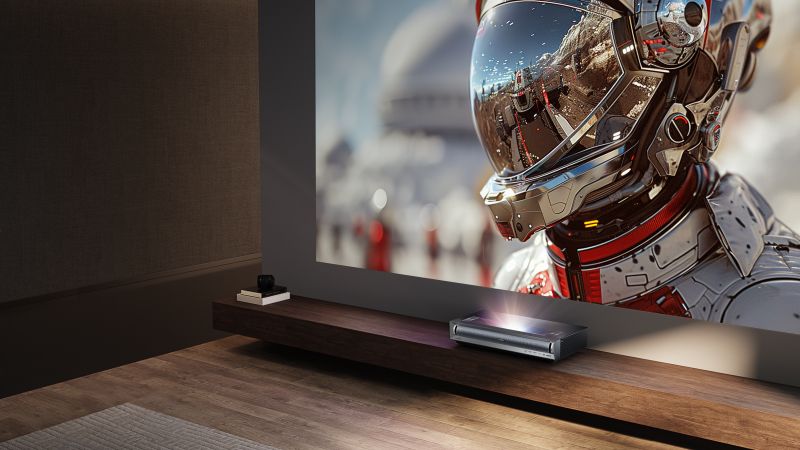
The PX3-PRO is listed as having a native contrast ratio of 3,000:1, and from our measurements the PX3-PRO exceeded this, measuring just over 4,000:1. This outperforms any UST projector I can think of to date including the Formovie Theater reviewed back in December of 2022. This is exceptional performance rarely seen in ultra-short throw projectors.
The PX3-PRO can project an image up to 150 inches diagonally, a feature that is becoming more common in the UST (Ultra Short Throw) space. Previously, many UST projectors maxed out at 120 inches, but with the rise of larger direct-view televisions at cheaper prices, it has become important for USTs to support larger screen sizes to stay relevant. Fortunately, the PX3-PRO delivers in this regard. However, with an image size of 150 inches diagonally, it becomes evident that a bit more light output would have been ideal. Despite this, the PX3-PRO can project at this size with a relatively short throw distance thanks to its throw ratio of 0.22:1, allowing for an 80- to 150-inch diagonal screen from as close as 4.7 to 18.1 inches away from the wall.
The PX3 also features Auto Keystone Correction, accessible during the initial setup or through the Auto Keystone Correction menu in the laser settings. This function utilizes the camera of a mobile device connected to the same network. Users are prompted to scan a QR code and enter a PIN, after which they take a photo and upload it for Auto Keystone Correction to begin. If unsuccessful, users can retry or opt for manual correction, available in the Manual Keystone Correction menu, which supports both 4- and 8-point correction.
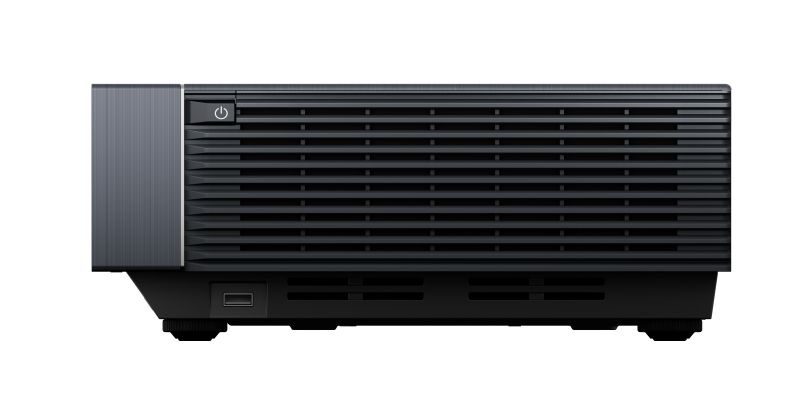
Using the Auto or Manual Keystone adjustments in combination with digital focus can help fine-tune the image as needed. It's important to note that keystone and 3D features are disabled if the user enables DLP Turbo Mode, which is necessary to achieve the lowest input latency for gaming. The PX3-PRO performs well in this area, with latency measuring 38ms at 30Hz, 21-25ms at 60Hz (depending on resolution), 14ms at both 1080p and 4K at 120Hz, and 7ms at 1080p when sending 240Hz.
Weighing 19.8 lbs and measuring 21.7 x 4.8 x 11.7 inches (WHD), the PX3-PRO is relatively compact and should be easy to set up in a suitable location. It supports front and rear table or ceiling installations. When installing on a tabletop, four adjustable feet assist with leveling the unit properly. For installation assistance, visit the ProjectorCentral Hisense PX3-PRO Throw Calculator.
The PX3-PRO utilizes Google TV as its operating system and streaming platform, bringing a wide range of features that users have come to expect, including but not limited to Chromecast, Google Assistant, and access to the Google Play Store for apps. It also comes with an authorized built-in streaming app for Netflix, as well as Disney+, Max, Hulu, Amazon Prime TV, and many more through the Google Play Store. Thanks to this integration, the smart platform is robust and eliminates the need for external streaming devices like Apple TV or Fire TV. Critically, the smart platform also accurately recognizes the dynamic range of the content being played, automatically adjusting picture modes and color spaces based on the content whether you're watching 1080p SDR or 4K HDR. Regarding the latter, the PX3-PRO supports Dolby Vision along with HDR10, HDR10+, IMAX Enhanced, and HLG.
The PX3-PRO offers ample I/O connectivity options to meet users' needs. It includes three HDMI ports, two of which are full 48Gbps HDMI 2.1 ports that support 4K at 120Hz, and one HDMI 2.0 port with eARC support. This thoughtful design allows users to connect current-generation gaming consoles like the Xbox Series X or PlayStation 5, which can handle 4K at 120Hz, to the HDMI 2.1 ports, while reserving the HDMI 2.0 port for eARC without occupying the higher-bandwidth ports. It's important to note that although the PX3-PRO accepts a 4K/120Hz signal, as with earlier Hisense projectors that feature wide-bandwidth HDMI 2.1 ports, these signals are eventually down-converted because the DLP chipset tops out at 4K/60Hz onscreen. This issue is universal among DLP manufacturers while they await a new hardware solution from Texas Instruments.
The remaining I/O includes two USB ports—one USB 3.0 and one USB 2.0—both with power delivery and media reading capability. A 3.5mm audio jack is available for headphones or external speakers along with an S/PDIF optical port, and there is an RJ45 LAN port and a service port. The PX3-PRO also supports Wi-Fi 6e, Bluetooth 5.3, and Control4 compatibility for home automation.
The PX3-PRO features a 50W front-firing speaker system by Harman Kardon, which delivers pleasant sound with decent midrange and adequate bass considering its size. This system is a noticeable upgrade from earlier Hisense USTs that used the company's own audio solution. Many users will find it sufficient on its own. While the system supports Dolby Atmos, be advised that the surround effect is minimal, though it provides clear dialogue, which is key. For a more immersive experience, users may prefer to use an external sound system, ideally through the HDMI eARC feature that allows transmission of lossless audio from the streaming platform or externally connected sources to an outboard AV receiver, prepro, or soundbar.

The PX3-PRO also supports 3D using active DLP link 3D glasses, a feature that is becoming increasing rare. The 3D performance was good, with no noticeable crosstalk, though I found the image to be a bit on the darker side—still very watchable, but I would have preferred a little more light output. My brief experience with 3D content was overall positive.
The PX3-PRO comes with an IR/Bluetooth remote that provides easy access to all the essential functions for navigating the menu system. The remote includes buttons for switching between Google TV user profiles, launching apps, selecting inputs, adjusting settings, and controlling volume. However, the remote lacks a dedicated button for switching between sound modes. It is generally responsive, with the exception of the Laser Level button for adjusting light output, which has a slight delay due to the laser needing time to adjust. This was the only minor issue I encountered while using the remote.
Performance
Color Modes. The PX3-PRO offers an impressive variety of picture modes, with over 22 options across both SDR and HDR formats. There are seven picture modes for SDR, eight for HDR, three for DolbyVision, four for HDR10+, and an additional mode for 3D. Each of these modes allows for independent settings and dynamic range adjustments, so they can be tailored to individual preferences. The available modes include Vivid, Standard, Sports, PC/Game, Energy Saving, Theater, and Filmmaker. In HDR, the same mode names are used, with the prefix "HDR," except for PC/Game, which becomes "HDR Game." Additionally, IMAX Enhanced is an available picture mode in HDR. In HDR10+, the modes are prefixed with "HDR10+" for Vivid, Game, Standard, and Theater. DolbyVision modes follow the convention of DolbyVision Bright, Dark, and an additional mode, DolbyVision Custom.
All the picture modes can be adjusted to perform similarly if desired, though they have slight differences out of the box (OOTB). Most picture modes exhibit a slight blue bias, with the level of blue depending on the color temperature setting of each mode. The color temperatures available are preset, with no option for a custom setting.
Basic picture settings include Contrast, Black Level (commonly referred to as Brightness), Color, and Hue. Contrast and Black Level are located in the Laser Luminance menu, while Color and Hue are found in the Color menu. Sharpness is located in the Clarity menu.
The PX3-PRO also offers advanced calibration controls, including a full Color Management System (CMS) for adjusting primary and secondary colors. It provides a standard 2-point white balance control for adjusting Gain and Offset, as well as a 20-point control for adjustments in 5% increments. Gamma controls are available to adjust tracking in 5% increments, based on the selected default gamma: 2.0, 2.2, 2.4, or BT.1886. Gamma generally tracks close to the selected setting, though not exactly. For example, a 2.4 gamma might track closer to 2.3, and a 2.2 closer to 2.1.
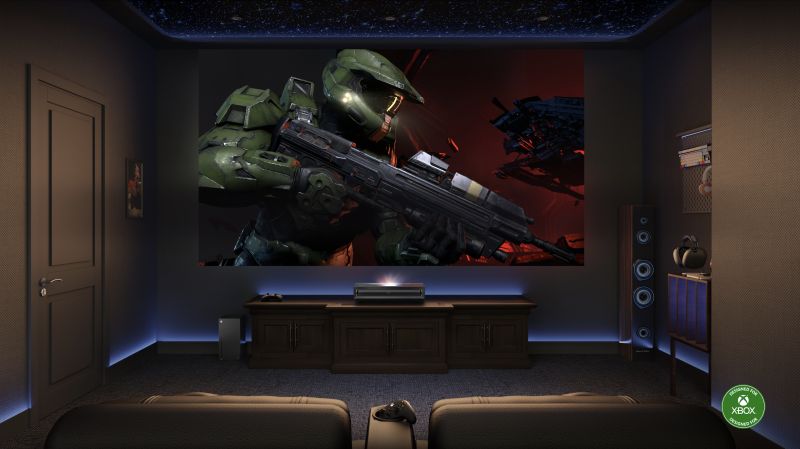
However, not all controls functioned as expected. The 20-point white balance adjustment was only effective between 5% and 70%, while adjustments between 75% and 100% made little to no visible change, even with aggressive modifications. Similarly, some saturation controls in the CMS had minimal effect, both visually and in measurements. Fortunately, this wasn't a significant issue, as the PX3-PRO's out-of-the-box tracking was quite good.
Hisense markets the PX3-PRO's gamut coverage as 110% of BT.2020, which is impressive, though as mentioned our measurements came up short, showing coverage of 94.34% in xy and 94.78% in uv. This is still excellent coverage, especially with most of today's HDR content mastered in the DCI-P3 gamut. For DCI-P3, the measurements were 99.82% in xy and 99.78% in uv.
Initial viewing of the OOTB picture modes was pleasant. While the blue bias was noticeable, it wasn't distracting, especially in picture modes like Theater, which are designed to be more accurate. Users who prefer a more accurate picture might want to start with the Theater mode, select the Warm 1 color temperature, and possibly reduce the Blue Gain setting slightly.
I started calibration by measuring the Theater picture mode with its default values using Calman Ultimate calibration software from Portrait Displays, a Colorimetry Research CR-250 Spectroradiometer, a Colorimetry Research CR-100 Colorimeter, and a Murideo 8K Seven Generator. The PX3-PRO was calibrated to 103-inch diagonal on an Elite Screens Aeon CLR Ambient Light Rejecting screen, which features a 0.6 gain.
Pre-calibration measurements had low dE (DeltaE) errors. (DeltaE is the metric used to determine the visible error. It has been determined that anything over a dE of 3 is visible, anything over 2.3 is a just noticeable difference for trained eyes and anything below 2.3 should ideally not be seen to the eye.) Grayscale pre-calibration measurements of Theater had dE errors showing an average of 0.8dE and a max of 1.8dE. Color gamut color points for the Rec. 709 color space had errors that averaged 1.1dE and a max of 2.6dE. A large color checker that tested across many color swatches representing blue sky, skin tones, etc., also showed low errors OOTB, with an average of 0.8dE and a max of 3.3dE, while saturation and luminance sweeps came in roughly the same.
Utilizing the white balance controls for adjustments I targeted the production industry standard D65 neutral gray white point using the available Gain and Offset controls, in addition to the standard picture controls and CMS.
Post calibration errors for Rec.709 were improved, though the improvement was small considering how accurate the PX3-PRO already was OOTB. This ultimately resulted in some of the averages dropping as low as 0.4dE and the max errors dropping to 2.4 in some cases. HDR calibration only required a small adjustment to the 2-point gain control while leaving color points untouched. A user could essentially use the PX3-PRO OOTB with only making a small adjustment to 2-point gain and will likely be very satisfied.
The devices I used for reviewing content post calibration were Apple TV 4K, R_Volution Player One 8K media player, and Xbox Series X.
1080p/SDR Viewing. For SDR viewing I watched The Blind Side via R_Volution Player One 8K. The SDR performance of the Hisense is excellent and it did exceptionally well during my viewing of this movie. Skin tones were accurate and shadow detail was good. I watched the majority of the entire movie and what stood out the most was when Mike was practicing football the first time. The trees and grass looked great, with excellent color.
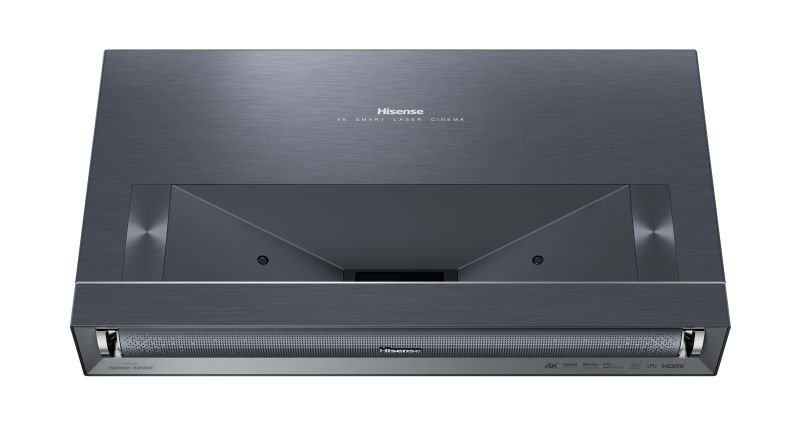
UHD/HDR Viewing. The first movie that I watched in HDR was the Pixar-animated Incredibles 2 via Apple TV 4K. The scene that I focused on was when ElastiGirl was listening to the transmission she was tracking when she sneaked into the apartment. The scene had good blacks, and shadow detail was okay—I did feel the blacks were a little crushed, but nothing that took away from the scene. When the Screenslaver appeared and they began to fight, the scene displayed good highlights and good dynamic range. Overall, the image was presented sharp and detailed.
The next movie that I watched in 4K HDR was A Man Called Otto via Apple TV. Everything looked good and just as I would have expected based on prior viewing on accurate displays. During the scenes where Otto was shopping for a rope, and making his rounds, skin tones and clothing looked natural with good detail, and the image was sharp and crisp. I did notice a small amount of DLP rainbow effect during the opening credits that was associated with a quick shift of my eyes, but it was very minimal.
The last movie I watched was another Pixar animated feature, Inside Out, via Apple TV 4K. Since the Hisense covers a good amount of the BT.2020 gamut I wanted to see how well it performed with highly colorful and saturated content. I mainly focused on the scene when Joy and Sadness enter the cave to save Bing Bong, and they first see the broccoli stalk. The PX3-PRO did well, but the broccoli stalk wasn't rendered in the way I expected to see it from prior viewings, with a rich, deep green. Essentially, what was missing was deep, low luminance saturation. The scene still looked good, but that extra low luminance deep color was missing.
Let's Talk Projectors!
The ProjectorCentral Forums is a great place to chat with other projector enthusiasts about all things projectors.
Join the Discussion
Gaming. I decided to play several different games from fighting, racing, and first-person shooters. I opted to mainly focus my gameplay on Xbox and PC. On Xbox I first played Tekken 8 which runs at 4K/60Hz. Gameplay felt good and responsive, I didn't feel as though I was missing combos after taking a little time to adjust to the difference in latency from normally playing on an OLED TV. Visuals were crisp and detailed on the characters and stages and provided an immersive experience. The next game I opted to play was Halo Infinite on Xbox at 4K/120Hz. I started the game from the beginning since I wanted to see the ship's interior, which has a nicely saturated red hue on various lights within the ship. Again, gameplay was very tight and responsive, and contrast was actually quite good as well during the various cutscenes shown of space—though I did see some posterization in a few of the scenes. All of the games I played performed well and looked great.
Conclusion
Hisense has done an excellent job with the PX3-PRO, offering users a feature-rich projector that performs well across multiple areas. The PX3-PRO is not only a fantastic projector for gaming but also highly capable for general content consumption. With excellent color reproduction, a wide color gamut, strong contrast, and support for all available HDR formats, the PX3-PRO should be one of the top choices for anyone in the market for an ultra-short-throw projector.
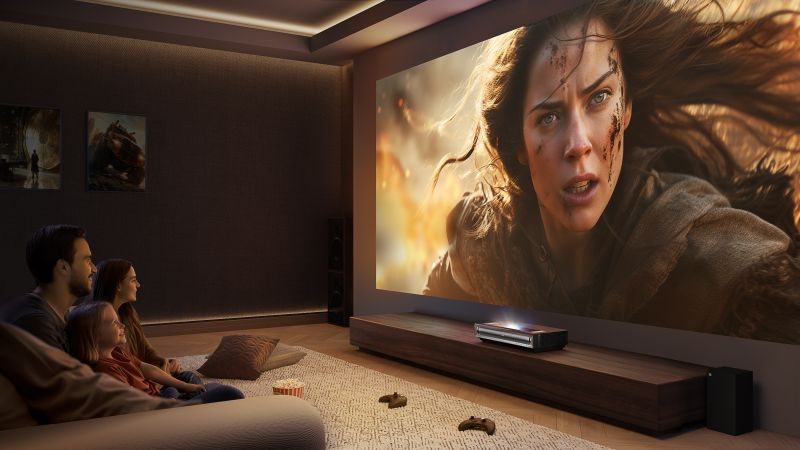
Additionally, the well-integrated Google TV smart platform minimizes the need for an external streaming device, and it functions properly in providing apps for all the top services, including Netflix, and in properly tracking and adjusting for SDR and HDR programs. The latter is a rarity among many USTs we've tested that either came with a separate streaming dongle or a substandard internal platform. Additionally, the built-in front-firing speaker system has been upgraded to where it performs adequately for those who prefer not to use an external sound system.
The ability to project a 150-inch diagonal screen is also a great feature. However, for screen sizes that large, the PX3-PRO could benefit from being slightly brighter, or at least being paired with a positive gain screen to maximize its potential versus the 0.6 gain lenticular screen ProjectorCentral usually recommends. My only other complaint was that some of the image adjustments, notably the 20-point white balance controls and CMS, don't function perfectly, though the unit remains fairly accurate overall.
In terms of price-to-performance, the Hisense PX3-PRO is arguably one of the best, if not the best, ultra-short-throw projectors available at the time of writing. With its robust feature set and impressive performance, it should be at the top of the list for anyone shopping for a UST projector today.
Measurements
Brightness. The Hisense PX3 is rated for 3,000 ANSI lumens. The brightest picture mode in both SDR and HDR was Vivid/HDR Vivid. This picture mode measured 2,669 ANSI lumens, which is 11% lower than Hisense's 3,000 rated lumen specification, though within the allowable 20% tolerance of the ISO21118 specification. (Editor's note: Readers should be advised that UST brightness measurements taken with a handheld luminance meter, as we do at ProjectorCentral, can experience a higher than normal margin of error.)
Hisense PX3-PRO ANSI Lumens
| SDR/HDR MODE | Laser Luminance Level 10 |
|---|---|
| Vivid | 2,653 |
| Standard | 2,304 |
| Sports | 2,589 |
| PC/Game | 2,562 |
| Energy Saving | 2,536 |
| Theater | 1,975 |
| Filmmaker Mode | 2,002 |
| HDR Vivid | 2,669 |
| HDR Standard | 2,562 |
| HDR Energy Saving | 2,589 |
| HDR Sports | 2,589 |
| HDR Game | 2,616 |
| HDR Theater | 2,028 |
| HDR Filmmaker Mode | 2,028 |
| IMAX Mode | 2,028 |
Brightness Uniformity. The Hisense PX3-PRO projecting a 103-inch diagonal image resulted in measured brightness uniformity of 79%. The brightest portion of the screen was the Middle Bottom sector, and the dimmest the Right Top. The difference in brightness on a full white screen wasn't noticeable nor was it noticeable while viewing content.
Fan Noise. The Hisense PX3-PRO did not have a published specification for audible noise at the time of review. Using Room EQ Wizard software and a Umik-1 microphone, my theater room ambient noise floor is 33.3 dBA. The Hisense PX3 measured a max of 39.1 dB for audible noise in all picture modes and brightness settings. The measurements were taken at a distance of approximately 3 feet from the unit.
Above: 39.1dBA
Rear: 38.3 dBA
Left: 36.8 dBA
Right: 35.9 dBA
Input Lag. Input lag measurements while using DLP Turbo Mode On and High Refresh Rate Mode On for 120hz:
1080p/30 = 38ms—DLP Turbo Mode ON
2160p/30 = 38ms—DLP Turbo Mode ON
1080p/60 = 25ms—DLP Turbo Mode ON
2160p/60 = 21ms—DLP Turbo Mode ON
1080p/120 = 14ms—DLP Turbo Mode ON and High Refresh Rate Mode ON
2160p/120 = 14ms—DLP Turbo Mode ON and High Refresh Rate Mode ON
1080p/240 = 7ms—DLP Turbo Mode ON
Connections
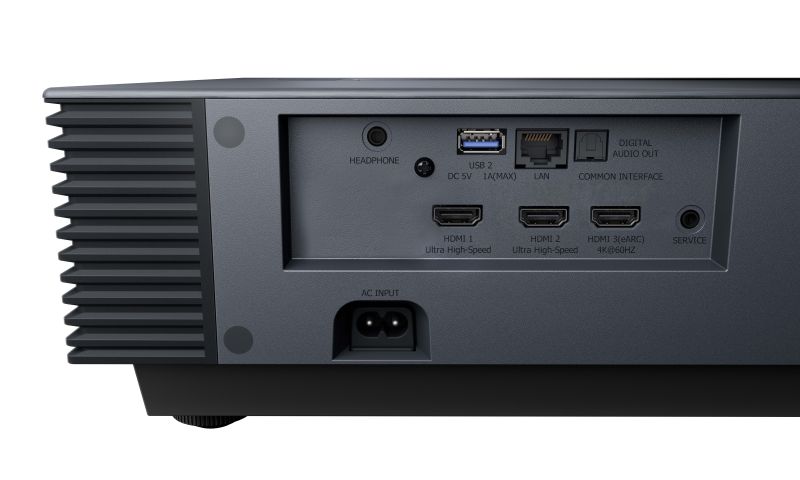
- HDMI 2.1 (x2; 48Gbps; HDCP 2.3)
- HDMI 2.0 (HDCP 2.2; eARC)
- USB 2.0 type A (located on side of unit; 5V-0.5A; Media Reader)
- USB 3.0 type A (located on rear of unit; 5V-1A; Media Reader)
- 3.5mm Headphone/Audio jack
- 1 RJ45 Lan port
- S/PDIF (Optical output)
- Wi-Fi 6e (802.11 ax)
- Bluetooth
Calibrated Settings
Calibrated image settings from any third-party do not account for the significant potential for sample-to-sample variation, nor the different screen sizes and materials, lighting, lamp usage, or other environmental factors that can affect image quality. Projectors should always be calibrated in the user's own space and tuned for the expected viewing conditions. However, the settings provided here may be a helpful starting point for some. Always record your current settings before making adjustments so you can return to them as desired. Refer to the Performance section for some context for each calibration.
SDR Settings
Image Mode: Theater
Laser Luminance
Laser Luminance Level: 10
High Dynamic: Off
Dark Detail: Off
Gamma: 2.4
Active Contrast: Off
Brightness Enhancer: Off
Color
Color: 50
Hue: 0
Color Temperature: Warm 1
Color Space: Auto
Dynamic Color Enhancer: Off
Clarity
Sharpness: 7
Smooth Gradient: Low
Super Resolution: Off
Noise Reduction: Off
MPEG Noise Reduction: Off
Motion Enhancement: Off
Calibration Settings
| Color | Hue | Saturation | Brightness |
|---|---|---|---|
| Red | 0 | 0 | 0 |
| Green | 0 | 0 | 0 |
| Blue | 3 | 4 | -1 |
| Yellow | 1 | 0 | 0 |
| Cyan | 0 | 0 | 0 |
| Magenta | 0 | 4 | 0 |
White Balance
2 Point
R-Offset = 0
G-Offset = 0
B-Offset = 0
R-Gain = 0
G-Gain = -1
B-Gain = -5
20 Point: On
| R | G | B | |
|---|---|---|---|
| Level 5 | -7 | -5 | -4 |
| Level 10 | -4 | -2 | -6 |
| Level 15 | -3 | -2 | -4 |
| Level 20 | -4 | 0 | -3 |
| Level 25 | -2 | -1 | 0 |
| Level 30 | -1 | 0 | 0 |
| Level 35 | -1 | 0 | 1 |
| Level 40 | -1 | 0 | -1 |
| Level 45 | -1 | 0 | 2 |
| Level 50 | -2 | 0 | 6 |
| Level 55 | 1 | 0 | -3 |
| Level 60 | -5 | -1 | 10 |
| Level 65 | 5 | 0 | -8 |
| Level 70 | -6 | -1 | 10 |
| Level 75 | 0 | 0 | 0 |
| Level 80 | 0 | 0 | 0 |
| Level 85 | 0 | 0 | 0 |
| Level 90 | 0 | 0 | 0 |
| Level 95 | 0 | 0 | 0 |
| Level 100 | 0 | 0 | 0 |
HDR Settings
Image Mode: HDR Theater
Laser Luminance
Laser Luminance Level: 10
High Dynamic: On
Dark Detail: On
Gamma: ST2084
Active Contrast: Medium
Brightness Enhancer: Off
Dynamic Tone Mapping: On
Color
Color: 50
Hue: 0
Color Temperature: Warm 1
Color Space: Auto
Dynamic Color Enhancer: Off
Clarity
Sharpness: 7
Smooth Gradient: Low
Super Resolution: Off
Noise Reduction: Off
MPEG Noise Reduction: Off
Motion Enhancement: Off
Calibration Settings
| Color | Hue | Saturation | Brightness |
|---|---|---|---|
| Red | 0 | 0 | 0 |
| Green | 0 | 0 | 0 |
| Blue | 0 | 0 | 0 |
| Yellow | 0 | 0 | 0 |
| Cyan | 0 | 0 | 0 |
| Magenta | 0 | 0 | 0 |
White Balance
2 Point
R-Offset = 0
G-Offset = 0
B-Offset = 0
R-Gain = 1
G-Gain = 0
B-Gain = -1
20 Point: Off
For more detailed specifications and connections, check out our Hisense PX3-PRO projector page.
To buy this projector, use Where to Buy online, or get a price quote by email direct from Projector Central authorized dealers using our E-Z Quote tool.
Thanks







